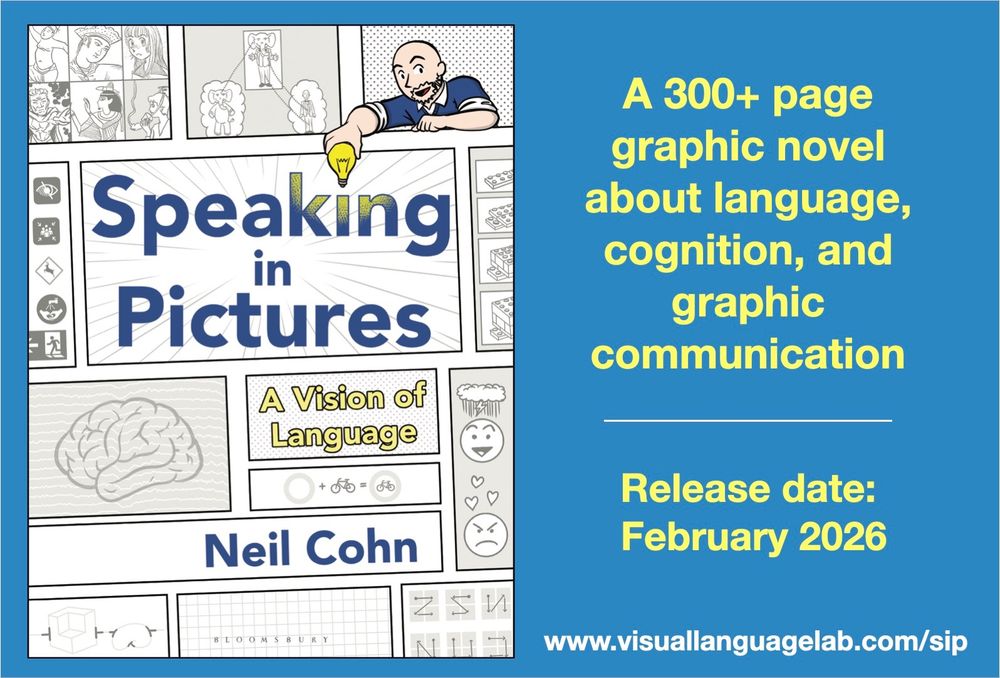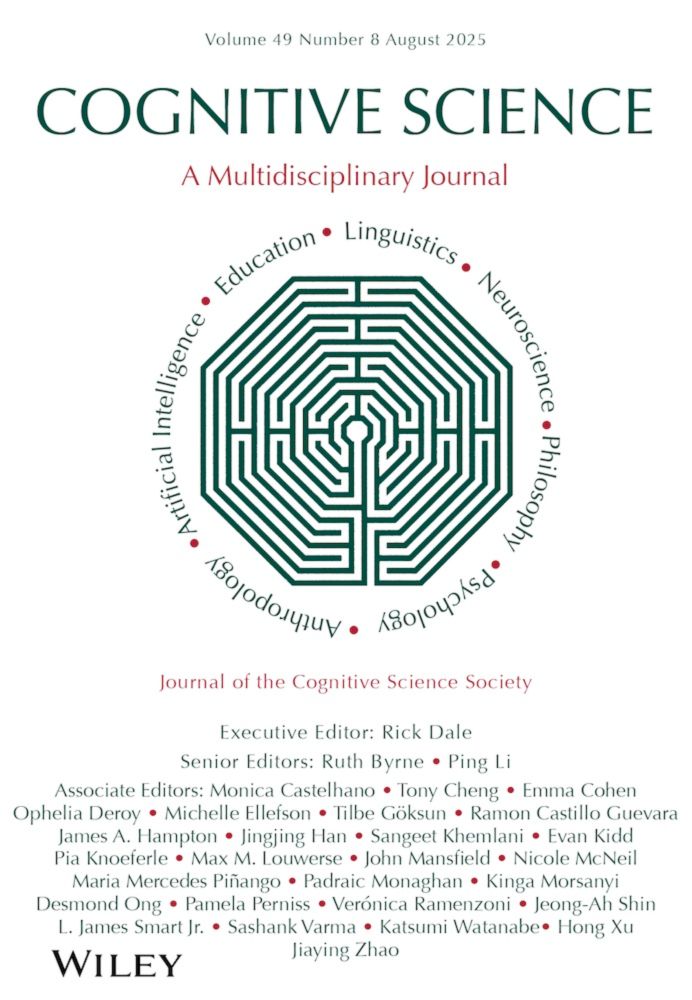CHIELD
I think @seangroberts.bsky.social may have used DAGs as well, and see also the CHIELD project: correlation-machine.com/CHIELD/
01.12.2025 16:50 — 👍 2 🔁 0 💬 1 📌 0

In our new tutorial, @meanwhileina.bsky.social and I walk you through meaningful hypothesis testing using a less known form of calculating Bayes Factor.
osf.io/preprints/ps...
People transitioning to Bayes often wonder how to decide if an effect is meaningful or not. Here you go... 1/🧵
26.11.2025 18:47 — 👍 25 🔁 13 💬 5 📌 0
Surgeon is God! Just saw him again two weeks ago here in Brum... was a killer set! He's SO good live :)
18.11.2025 17:30 — 👍 1 🔁 0 💬 1 📌 0
Gorgeous!
07.11.2025 07:54 — 👍 1 🔁 0 💬 1 📌 0

Prospective graduate students: Purdue Linguistics is having a virtual open house on Friday, Nov 7 at 12:00pm EST. You can sign up here: lnkd.in/g8XimXcG
Please note that I am not recruiting any new graduate students but several of my wonderful Purdue colleagues are.
17.10.2025 13:37 — 👍 5 🔁 2 💬 0 📌 0
End of an era! You've done SO MUCH for our department - thank you for all the important things you've contributed throughout these many years, and good luck with your future journey! ❤️
17.10.2025 16:41 — 👍 3 🔁 0 💬 1 📌 0

Proportion of articles containing at least one inconsistency / decision inconsistency. (Applied Psycholinguistics (APS), Language and Brain (BAL), Bilingualism: Language and Cognition (BLC), Journal of Memory and Language (JML), Journal of Psycholinguistic Research (JPR), Linguistic Approaches to Bilingualism (LAB), Language and Speech (LaS), Language Cognition and Neuroscience (LCN, formerly Language and Cognitive Processes), Language Learning and Technology (LLT), Journal of Language and Social Psychology (LSP), Journal of Child Language (JCL), and Studies in Second Language Acquisition (SLA), Journal Of Speech Language And Hearing Research (SLH)).
New paper led by Dara Etemady: Statistical reporting inconsistencies in experimental linguistics.
Almost half (49%) of all articles contained at least one inconsistent p-value. 12% contained an inconsistency that may have affected the statistical conclusion."
escholarship.org/uc/item/3736...
10.10.2025 06:45 — 👍 17 🔁 8 💬 0 📌 1
Apply for AI and Linguistics (Assistant, Associate or full Professor) | U-M Careers
Reminder!! We are hiring in Linguistics at Michigan with a focus on "AI and Linguistics" (broooaaadly construed). This is part of a cluster of positions in Psychology and Philosophy in collaboration with the Cognitive Science program. Applications now open!
careers.umich.edu/job_detail/a...
30.09.2025 14:07 — 👍 14 🔁 6 💬 0 📌 0
All of us (@kanishka.bsky.social @kmahowald.bsky.social and me) are looking for PhD students this cycle! If computational linguistics/NLP is your passion, join us at UT Austin!
For my areas see jessyli.com
30.09.2025 19:30 — 👍 4 🔁 5 💬 0 📌 0
🚨Open immediately!! (rolling application review)🚨: Postdoc w/ the amazing Tamar Gollan, Uni. Cal. San Diego, bilingual speech production and cognitive control in aging and Alzheimer’s disease psychiatry.ucsd.edu/about/LAB_Go...
30.09.2025 18:17 — 👍 10 🔁 7 💬 0 📌 0
I finally got the time to check our bird field guide corpus for this. Different authors use the onomatopoeias "wek", "wuck", "wuk wuk", "kuk", or "cuk cuk". One author describes the territorial call as "kuk kuk keekeekeekeekeekeekeekuk kuk"
29.09.2025 18:32 — 👍 3 🔁 0 💬 1 📌 0
And I truly meant what I said!! It was a blast reading this again!
29.09.2025 18:28 — 👍 1 🔁 1 💬 0 📌 0
I've also had BackBlaze before and then got annoyed. Recently switched to iDrive and liking it so far.
19.09.2025 07:59 — 👍 3 🔁 0 💬 2 📌 0

PhD student in Linguistics, sign language
The Department of Linguistics at Stockholm University conducts research and offers education in a number of areas such as child language development, computational linguistics, general linguistics, ph
Application for a PhD position at our department is now open! We are looking for applicants that are interested in areas of sign language linguistics, general sign language studies, or deaf bilingualism/multilingualism. Deadline is 15th Oct. Please share away! su.varbi.com/en/what:job/...
19.09.2025 05:05 — 👍 26 🔁 23 💬 1 📌 0

Assistant Professor of Psychology - Human Cognition or Cognitive Neuroscience
University of California, Davis is hiring. Apply now!
UCDavis Psych is hiring an Assistant Professor in Human Cognition or Cognitive Neuroscience 🧠✨
Come join a vibrant, collaborative dept and live in a fun college town near Sacramento, San Francisco, Napa, and Lake Tahoe. Applications due Oct.21.
Please share widely!
recruit.ucdavis.edu/JPF07300
08.09.2025 20:57 — 👍 39 🔁 29 💬 1 📌 0

Miyagawa Shuntei's 1898 painting, "Playing Go (Japanese Chess)"
How to quantify the impact of AI on long-run cultural evolution? Published today, I give it a go!
400+ years of strategic dynamics in the game of Go (Baduk/Weiqi), from feudalism to AlphaGo!
16.09.2025 14:04 — 👍 108 🔁 46 💬 2 📌 9
Was fun working on this paper on negation in BSL led by Gab Hodge and w/ Kearsy Cormier and @adamcschembri.bsky.social!
Paper is open access and available here:
doi.org/10.1515/opli...
15.09.2025 09:40 — 👍 15 🔁 1 💬 0 📌 0
Yay, thank you! So happy to hear they were useful :)
15.09.2025 08:10 — 👍 1 🔁 0 💬 0 📌 0

University of South Carolina has *7* tenure-track faculty positions in Neurobiology of Language:
tinyurl.com/USC-Faculty-...
Positions in COMD, Psych, Linguistics, School of Medicine.
@snlmtg.bsky.social #SNL2025, we will have a booth.
w/@rutvikdesai.bsky.social @imb-uofsc.bsky.social
09.09.2025 14:49 — 👍 52 🔁 29 💬 4 📌 3
Our department is hiring! We're looking for a cognitive/developmental psychologist who uses computational approaches to study human cognition and behavior to address learning, development, and education. Feel free to reach out with questions!
18.08.2025 14:55 — 👍 27 🔁 25 💬 0 📌 1
I find it endlessly frustrating that one of the biggest empirical findings from sociolinguistics is consistently ignored. Change doesn't come from children making mistakes. Change comes from adolescents incrementing existing probabilistic patterns.
I haven't read this paper but hopefully it's good.
09.09.2025 21:30 — 👍 116 🔁 37 💬 9 📌 0


“Children are not the main agents of language change” by Limor Raviv, Damián Blasi and Vera Kempe (Sep. ’25) pure.mpg.de/rest/items/i...
10.09.2025 00:37 — 👍 2 🔁 2 💬 0 📌 0

A universal of speech timing: Intonation units form low-frequency rhythms | PNAS
Intonation units (IUs) are a hypothesized universal building block of human speech
[W. Chafe, Discourse, Consciousness and Time: The Flow and Displ...
📣new and exciting paper alert! 📣
www.pnas.org/doi/10.1073/...
Ever wonder what's the rhythm of speech -- across languages?
1/10
W/ Maya Inbar and Eitan Grossman, we analyzed over 650 recordings from 48 languages, focusing on intonation units—short prosodic phrases that structure speech in time.
26.08.2025 09:16 — 👍 60 🔁 16 💬 2 📌 2

RTG - Universität Bielefeld
Der SFB setzt sich für eine qualitativ hochwertige Ausbildung von Doktoranden und Postdoktoranden ein und bietet Nachwuchswissenschaftlern ein Umfeld, das es ihnen ermöglicht, ihr Potenzial voll zu en...
📆 Reminder! Application deadline for incoming researchers (PhD students & postdocs) is August 31st!
If you want to come work with us in Bielefeld, apply for one of our scholarships. We would love to have you! More infos here 👉 www.uni-bielefeld.de/sfb/sfb1646/...
#BLinguistik #linguistics
22.08.2025 10:55 — 👍 10 🔁 9 💬 0 📌 0

Speaking in Pictures by Neil Cohn, 300+ page graphic novel about language, cognition, and graphic communication
I got the proofs today for my upcoming graphic novel about language, cognition, and visual communication and I cannot contain myself with how excited I am for this book to finally come out after working on it for 7 years 😱 visuallanguagelab.com/sip
21.08.2025 11:17 — 👍 87 🔁 19 💬 2 📌 4
Apply - Interfolio
{{$ctrl.$state.data.pageTitle}} - Apply - Interfolio
Another job here at Michigan - this one in Linguistics! Part of a cluster of hires with a focus on Cognitive Science and AI. Happy to chat to interested folks. apply.interfolio.com/171006
15.08.2025 12:36 — 👍 17 🔁 10 💬 0 📌 1

New book on ideophones
Williams, J. P (ed.). 2025. Capturing expressivity. Contents, methods, and techniques for linguistic research. OUP.
https://global.oup.com/academic/product/capturing-expressivity-9780192858931?cc=es&lang=en&

New book on ideophones: TOC
Williams, J. P (ed.). 2025. Capturing expressivity. Contents, methods, and techniques for linguistic research. OUP.
https://global.oup.com/academic/product/capturing-expressivity-9780192858931?cc=es&lang=en&

New book on ideophones
Williams, J. P (ed.). 2025. Capturing expressivity. Contents, methods, and techniques for linguistic research. OUP.
https://global.oup.com/academic/product/capturing-expressivity-9780192858931?cc=es&lang=en&
📢 New publication
Interested in #iconicity? Fascinated by #ideophones?
Craving for #fieldwork in this area?
Check out this book and ideas will come...
I explain how to conduct #psycholinguistic research in #minority languages such as #Basque
@oxfordacademic.bsky.social @psylexlab.bsky.social
14.07.2025 11:46 — 👍 9 🔁 4 💬 0 📌 2
Hello Django 😍
I'm definitely in the wrong field
15.07.2025 03:03 — 👍 2 🔁 0 💬 2 📌 0
Postdoc @ UCL studying causal judgment, counterfactual thinking, and metacognition
https://kevingoneill.github.io
Experimental mixed electronica artist/video game composer ig: rmxcat https://linktr.ee/remixedcat Game music packs: https://remixedcat.itch.io
Using metaphors and analogies to explain Software Engineering in fun ways: https://youtube.com/@metaphoricallyspeaking
Staff Software Engineer. Passionate about DDD, CQRS, Event Sourcing and Distributed Systems.
Kayaking, too.
Retro tech, early web & vintage computing. 80s, 90s, 2000s nostalgia. Follow for daily posts.
Cognitive Scientist @ Vassar College. Interested in language, metaphor, and thought, amongst other things
Philosopher and applied mathematician at UC Irvine. Author of The Misinformation Age and Origins of Unfairness. Irish dancer. Mother. Mother of Chickens.
cultural evolution, behavioral ecology, math models, data provenance, MOSAIC group leader @ Max Planck Institute for Evolutionary Anthropology + faculty at the Leipzig School of Human Origins https://babeheim.com/
Director of Research and Training | Bellingcat
Assistant Professor | Utrecht University
PhD, Criminology & Sociolegal Studies | University of Toronto
www.giancarlofiorella.com
interested in iconicity, sound symbolism, language contact, art, puppies, puzzles&kittens
ex @gabolices on twitter
also at fediscience.org (@gabriella)
Linguist, nature appreciator, big fan of sambal & soursop. All things Austronesian & NW New Guinea. Swarthmore/Philly. She/sie/lei/dia/andi.
cybernetic cognitive control 🤖
computational cognitive neuroscience 🧠
postdoc princeton neuro 🍕
he/him 🇨🇦 harrisonritz.github.io
Senior Lecturer in French and Linguistics, Westminster | Research on language in society | Associate Editor, Journal of Sociolinguistics | Research Notes Editor, Journal of French Language Studies.
https://sites.google.com/view/jonathan-kasstan/home
Neuroscience, piano rock, dad jokes
Neurologist, Cognitive Neuroscientist. Director: Penn Center for Neuroaesthetics https://neuroaesthetics.med.upenn.edu/
Author: The Aesthetic Brain
policy, $, political economy of race // 70-80s soul, 90s hip hop // #DubNation // proud product of miscegenation // Berkeley prof (formerly: Princeton CSDP, UW)
Assistant professor of language and communication at the VU Amsterdam. Conversation analysis, ethnomethodology, multimodality (he/him, hɔɪ~hoʊi)
Simulating sci-fi novels and calling it cultural evolution
Centre for Culture and Evolution | Brunel University London | https://j-winters.github.io
Writing about birds in people history and people in bird history
birdhistory.substack.com
Linguist, musician, and aspiring adrenaline junkie 🧗 Postdoc at Durham University, researching children's role in cultural evolution
@durhampsych.bsky.social
@durhamdcerc.bsky.social
(she/her) 🌈
https://aislinnkeogh.github.io/
















